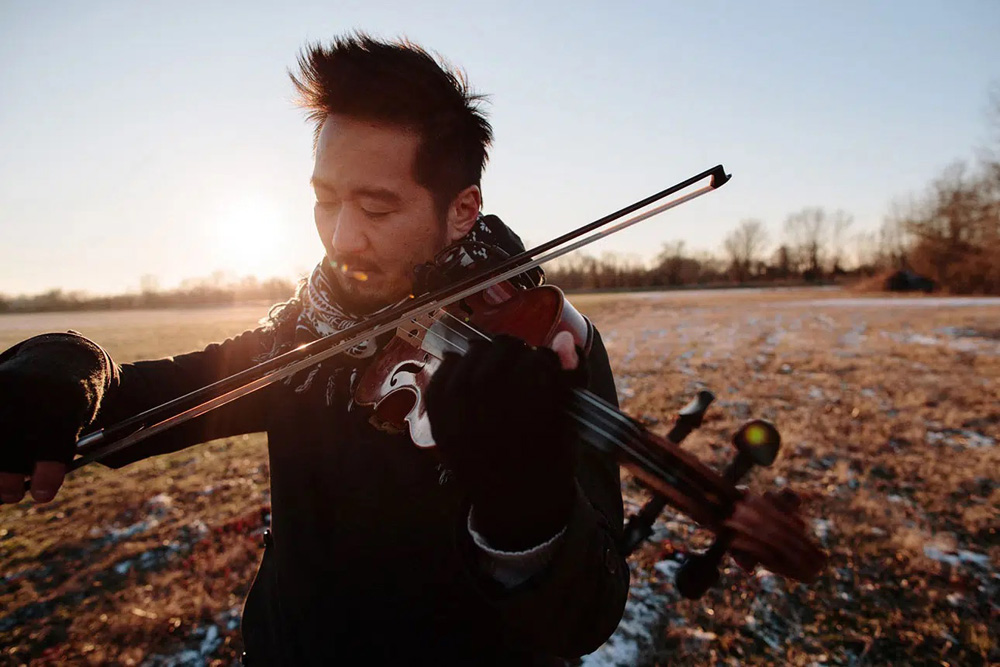Even after production ended on “Omoiyari: A Song Film,” Kishi Bashi has had to adjust to being part of a movie. The multi instrumentalist singer/songwriter who has performed as a solo artist and as part of the backing bands for Regina Spector and Of Montreal grew comfortable long ago with taking center stage or complementing what was happening there, but when either way he’s been raring to go, the time it takes even for a screening to end so he can engage with an audience has come as a surprise.
“I’m getting used to waiting around for the movie to end [at screenings before I go out for a Q & A]. That’s new for me. I’m a performer, so I’m usually just like showtime is you go,” the now multidisciplinary artist told me recently. “So that’s a little unusual for me, but I’m really enjoying it.”
It took over six years to bring “Omoiyari” to the screen and at just over an hour long, it is as carefully crafted as any composition the artist has ever worked on, and as much time was required due to the typical rigors of filmmaking, it would be fair to say it required more of Kishi Bashi when the violinist had to do some soul-searching about what he wanted the project to be. Initially conceived as a reflection on the Asian American experience after World War II in which the U.S. set up internment camps for Japanese Americans when considered an enemy of the state, the film evolved with the help of co-director Justin Taylor Smith into a personal story of Kishi Bashi reconciling his own roots in the country where growing up in Virginia among a largely caucasian community, he wasn’t entirely conscious of his Asian identity, though certainly made aware from time to time that because of his appearance he was an outsider, though he was raised no differently than his classmates.
When visiting the sites of internment camps still standing such as Heart Mountain in Wyoming, Kishi Bashi takes stock of all the Japanese American citizens had to give up before being forced into the camps, abandoning decades of building prosperity in their adopted home country through farming on the west coast, but equally harrowing material emerges from the suburbia he grew up in where he can look back with hard-won perspective and realize how anti-Asian sentiment shaped his life and continues to have a hold over people as places such as Pacific Northwest, home to Bainbridge Island, the first place where Japanese Americans were interned – at a repurposed former livestock center, no less, is once again becoming a flashpoint for contentious immigration debates as refugees are being detained.
Starting out filming well before COVID brought a rise in anti-Asian rhetoric to national consciousness, “Omoiyari” illuminates how it has always been there yet how the community has shown perseverance, with his own nimble playing of the violin exhibiting the strains necessary to be graceful, and after premiering last year at SXSW, “Omoiyari” is stepping off the festival circuit and moving into a nationwide release and Kishi Bashi generously spared a few minutes to talk about how the film came together, how his own role within it changed and how he not only was reflecting on history but ended up capturing it as it was happening during these tumultuous times.
How did this come about?
It’s been a six-year process. [Justin Taylor Smith] is an accomplished action sports cinematographer and editor, who was working on some big snowboard movies, hired me to be a composer [on some projects], for Red Bull — there’s a movie called “The Fourth Phase,” and we really clicked because he’s a musician too, so we’re always aligned with our musical tastes and how film and music work together, and how they should hit. And this started as a research trip with a bunch of grad students from Brown, and also with the orchestral improvisation piece that I composed in the summer of 2017, and it was supposed to be a short behind-the-scenes making-of this piece, but then we realized that there was a lot more to tell.
Were you always at the center of it, being this larger history of Japanese American history?
No, I really hate the camera, so that was something I had to get used to. But I like interviewing people, so that’s something I got really good at. and it was hard to really put myself in there, but because I realized that if we made it about me, then it would make it more interesting or engaging as a concept instead of just a lot of talking heads.
This coalesces around Heart Mountain in Wyoming, but was there much of a plan in terms of the itinerary?
Yeah, we did the first trip, and where I met Erin Aoyama – who used to be more in the movie [than she is] in the final cut – but she was connected to Heart Mountain and introduced us to a lot of people. Then we went on three of their pilgrimages, and I climbed Heart Mountain and got to know the community. I consider them my friends [now] and Justin also lived in Bozeman, Montana, which is like one state over, so it was something [where] you just meet a community and you just get sucked in because they’re great people. We ended up filming there at the museum, [which] really helped us and they were very generous with their resources.
Then one thing led to another. There’s a story I wanted to tell that had to do with incarceration and then the history prior to that. But we did a lot of tangential filming, [where people] talked about mass incarceration, but they also talked about gender inequity and there was a lot of things I wanted to get into. I also wanted [this] to be kind of whimsical, or have non-sequiturs in in it too [because] it was the kind of thing with exploratory filmmaking [where] you have to just go out there and grab stuff until basically your money runs out, so that’s what we did.
I wondered how extemporaneous the musical moments might’ve been when you’re going to these places – would you be subsequently inspired to write music for the film and return or was it really all in the moment?
Because [Justin and I] were so aligned in our vision, it was pretty easy to conceptualize this song film. We wanted this to be a movie [fusing] music and documentary filmmaking and I always had the idea of a song film [where] I was going to improvise something and that would become the transition to underscore what we wanted to talk about with historical archival [materials] and interviews. I did a lot of different improvisations as well as some songs, so we could have the flexibility of really having musical moments interspersed throughout this historical documentary.
It’s impressive how you’re able to relay the entire history of Japanese-American trade relations and the path to Hiroshima so concisely and elegantly, in part because of the brisk underlying score. Was a sequence like that tricky to cut together?
Yeah, starting in 1853 with Commodore Perry. That was something that always intrigued me because I really did think, “Here’s Pearl Harbor – [this is] World War II.” There’s all these things in your history book when you’re in high school that you never really realized the nuance. There are simmering global tensions that are happening, so that one I had a little conversation with myself and sketched it out. I just recorded a little casual version of what I wanted to do and then Justin put some crazy gypsy jazz music under it and edited that with archival, just based on what I was talking about. He’s a brilliant editor, so that’s how that one came about and it was fun. I won’t lie.
You actually were filming at least some of this pre-pandemic before anti-Asian rhetoric became recognized as a national issue. Was that dialogue informing the film you were making as you were in the edit?
It just completely complimented our message in that racism exists in America, but also, there’s a lot of nuanced conversations about racism within minority [circles]. We talked [about how] my identity [played into] the model minority myth where it’s more nuanced than the easy top-down, white people oppressing everybody else kind of thing, which is easy for the media to dispel. [So we were offering] more an update that totally just made sense for a movie because it is about systemic racism.
Was it always in the cards to go to Japan?
Yeah, when we started to realize this movie is about identity. [Japan] is also like a place I go to frequently to perform, so I was [personally] connected too, and we filmed for 10 – 15 days to really bolster the idea of biculturalness and show people that you could live between cultures and feel good about it.
What was it like to film in some of those public spaces there?
The Tokyo firebombing memorial — that was a somber moment. There’s a beautiful little memorial there and I was looking for something to memorialize that experience because it’s easy to just think about the [destruction of the] atom bomb, but you don’t realize [everything surrounding that destruction]. I’m a big fan of the documentary “The Fog of War,” where they talk about how they bombed Japan to shit before the atom bomb, so I wanted to showcase the mutual suffering that everybody was having during World War II and the lunacy and unfettered aggression.
It isn’t just a larger world history that you’re depicting with the film, but a personal one as well. What’s this been like for you to have as a time capsule within your own life and starting to get it out into the world?
It’s great. My parents love it. My brother came last night [to a screening] and he didn’t make the final cut, but there was an interview of him in an earlier version and it reminds me to keep in touch with my daughter. She’s a teenager now, so it’s great to to see them like that, so there is a time capsule [quality to it] of sorts. And getting to travel with it a little bit has been super exciting, especially [when] there’s nothing we can do about it anymore. Like [the film is] out there and the reception’s been great, especially [from] a lot of Japanese-American community. They really deeply appreciate the movie, which makes me happy.
“Omoiyari: A Song Film” opens on October 6th in New York at the IFC Center and in Los Angeles at the Laemmle Glendale. A full list of theaters and dates is here.




